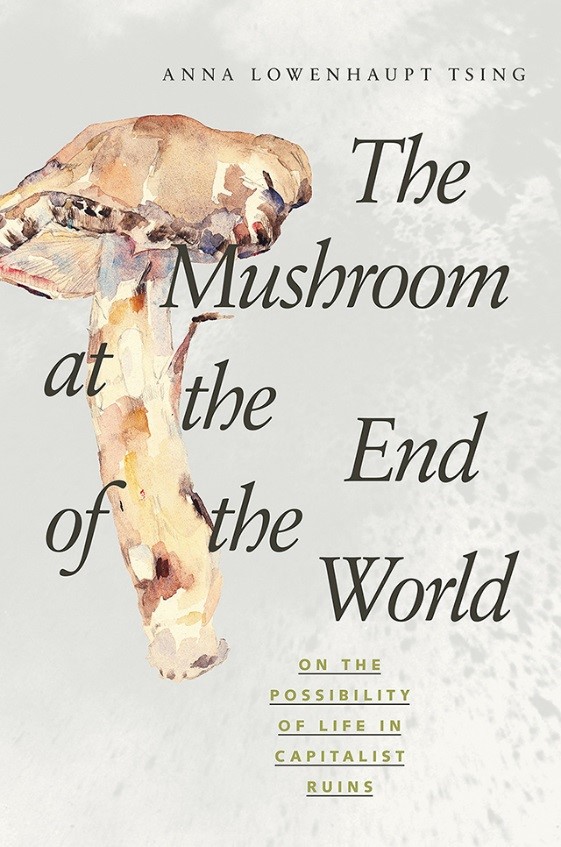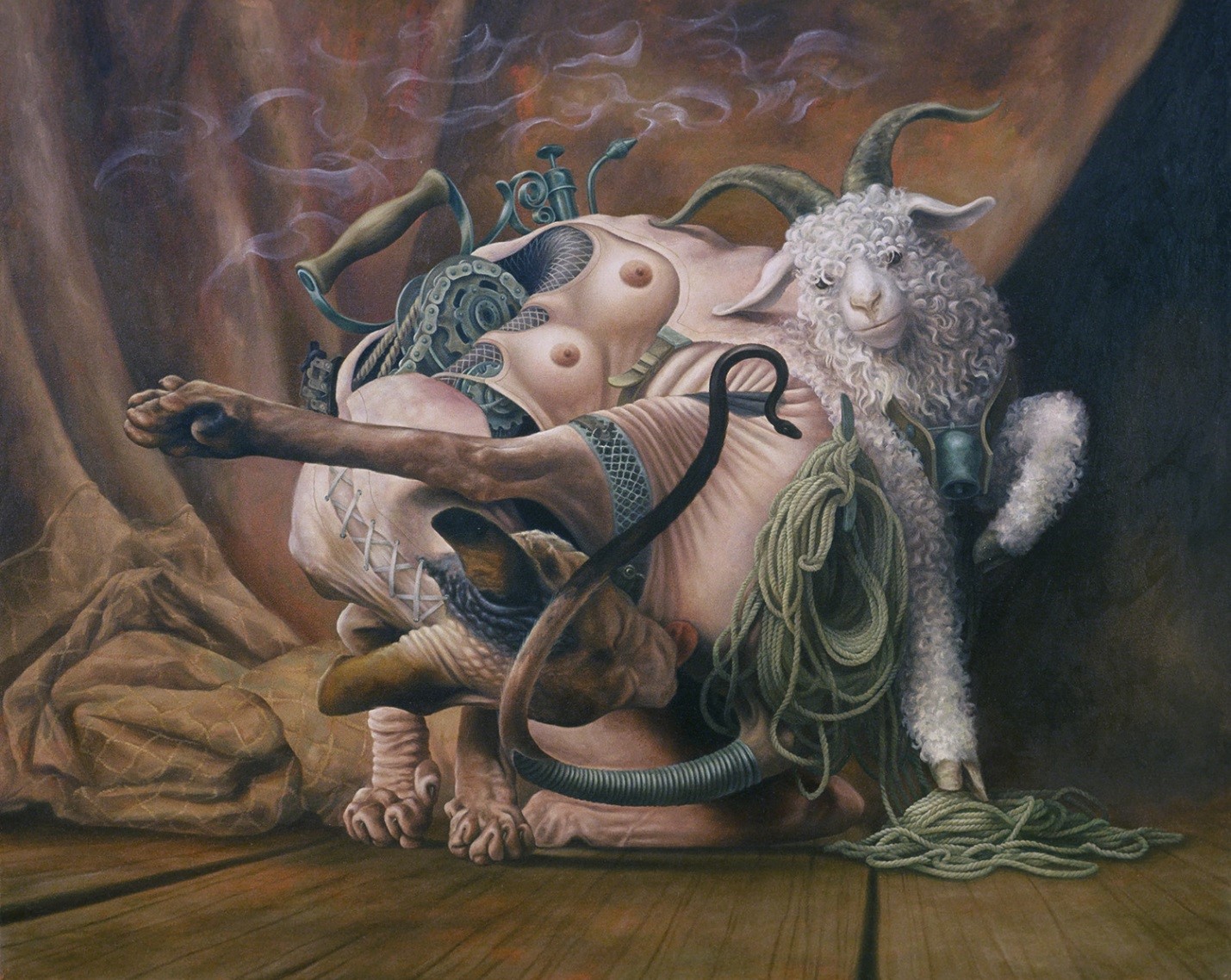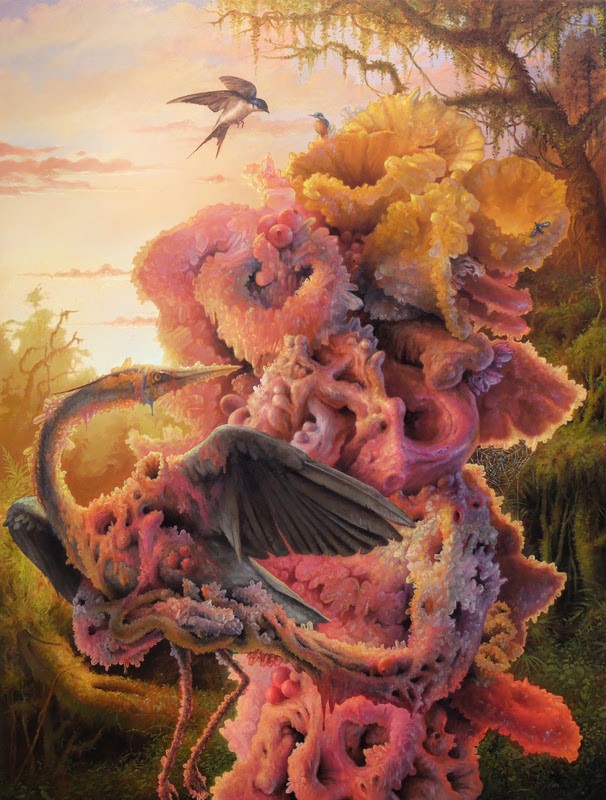[On September 13th, 2018 the Unit for Criticism and Interpretive Theory hosted the lecture "The More than Human Anthropocene" by visiting scholar Anna Tsing (UC-Santa Cruz). Below is a response to the lecture by Michael Uhall (Political Science).] Salvaging the Feral Written by Michael Uhall (Political Science) Most of Anna Tsing’s presentation on the “more-than-human” Anthropocene speaks to the methodology and substance of her latest project, a multimedia online endeavor entitled Feral Atlas, hosted by Aarhus University. Central to this developing project is its focus on feral agencies and feral dynamics, topics that will be somewhat familiar to anyone who has read Tsing’s recent work, especially The Mushroom at the End of the World, which sketches out the embeddedness of matsutake mushrooms in various cultural, historical, and political economic webs of relation.  The “feral” here refers to the numerous inhuman actors that détourn, participate, and transform (or potentially undermine) the various components and trajectories that contribute to our strange new epoch. Take note that Tsing does not want to condemn or valorize the concept of ferality. To the contrary, she adopts a largely descriptive or diagnostic approach to the action of feral actors. What can a feral body (or a feral dynamic, or a feral interaction) do? Blizzards of examples of ferality compose the project: emerald ash borers hitching rides in globally ubiquitous wooden shipping pallets, hungry storks changing their migration patterns to pick organic waste from trash dumps, microplastic-saturated cows eating garbage bags, mosquitoes stowing away on slave ships during the triangle trade , Chernobyl blueberries carrying deadly payloads of hard rads hidden in their sweet flesh … It is a stampede of hybrids. [caption id="attachment_1809" align="alignnone" width="1429"]
The “feral” here refers to the numerous inhuman actors that détourn, participate, and transform (or potentially undermine) the various components and trajectories that contribute to our strange new epoch. Take note that Tsing does not want to condemn or valorize the concept of ferality. To the contrary, she adopts a largely descriptive or diagnostic approach to the action of feral actors. What can a feral body (or a feral dynamic, or a feral interaction) do? Blizzards of examples of ferality compose the project: emerald ash borers hitching rides in globally ubiquitous wooden shipping pallets, hungry storks changing their migration patterns to pick organic waste from trash dumps, microplastic-saturated cows eating garbage bags, mosquitoes stowing away on slave ships during the triangle trade , Chernobyl blueberries carrying deadly payloads of hard rads hidden in their sweet flesh … It is a stampede of hybrids. [caption id="attachment_1809" align="alignnone" width="1429"] © Heidi Taillefer [/caption] Theoretically speaking, Tsing offers us seven insights or “methods” intended to serve as guidelines for studying the Anthropocene. She wants to show us how the very topos of the Anthropocene consists of far more than just humans. Rosi Braidotti, Bill McKibben,Jedediah Purdy, Steven Vogel and so many others direct our attention to the fact that, in the Anthropocene, “the trail of the human serpent is thus over everything” (William James). But Tsing is more interested in exploring the degree to which feral, inhuman actors penetrate and possibilize every human activity and endeavor – even now, during the sixth mass extinction of life on earth. In this mode, consider a recent, morbidly amusing bit of clickbait a kind of icon or synecdoche of the world of the human today: “Mummified human corpse filled with bees, wasps and a squirrel discovered hanging from a tree.” [caption id="attachment_1810" align="align-right" width="365"]
© Heidi Taillefer [/caption] Theoretically speaking, Tsing offers us seven insights or “methods” intended to serve as guidelines for studying the Anthropocene. She wants to show us how the very topos of the Anthropocene consists of far more than just humans. Rosi Braidotti, Bill McKibben,Jedediah Purdy, Steven Vogel and so many others direct our attention to the fact that, in the Anthropocene, “the trail of the human serpent is thus over everything” (William James). But Tsing is more interested in exploring the degree to which feral, inhuman actors penetrate and possibilize every human activity and endeavor – even now, during the sixth mass extinction of life on earth. In this mode, consider a recent, morbidly amusing bit of clickbait a kind of icon or synecdoche of the world of the human today: “Mummified human corpse filled with bees, wasps and a squirrel discovered hanging from a tree.” [caption id="attachment_1810" align="align-right" width="365"] © Adrian Cox [/caption] First, Tsing says, the Anthropocene is patchy. In other words, despite the focus on planetary dynamics characteristic of so much discourse about climate change, for example, actual processes of carbon emission and ecological destruction alike are concentrated in specific localities, or “patches.” The ecological crisis is a combined and uneven apocalypse. Second, these patches are organized by “imperial and industrial infrastructures,” or the material means of production that maintains the patchwork politics of world-ending. In turn (and third), these infrastructures emerge within programs of “invasion, empire, capital, and acceleration,” all of which are drivers that Tsing calls “Anthropocene detonators.” Fourth, these infrastructures show us what Tsing calls “landscape structures,” or the specific material composition of sites in the patchwork that sustain our Anthropocene machine even as it bleeds to death. These sites interact at a distance, both with other sites and with every other actor. Recall a core principle of ecological reason, namely, that everything is connected to everything else – by hook or by crook, both in space and time. Or, as Tsing puts it, “Co-temporality is a necessary framework for critical description.” Things happen together. Tsing proposes two final methods: ontologically appropriate mapping and digital architecture. Both of these methods offer ways of cutting through, cutting up, and rewiring traditional modes of knowledge presentation and production. Regarding maps, as Tsing clarifies, they can take many forms other than the God’s eye view that conventional or unifying maps suggest. Here Tsing’s analysis recalls ecological or phenomenological perspectives, ranging from Jakob von Uexküll’s biosemiotic concept of Umwelt to Bryan G. Norton’s emphasis on the value of multiscalar analysis in adaptive landscape management. Similarly, digital architectures allow a more “playful and performative” presentation of information, with anchor texts and inline links enabling nonlinear associations and redirecting the reader’s attention in novel ways. All in all, Tsing’s new project sounds like a fascinating contribution to Anthropocene studies. That being said, at least one concern comes to mind. Is it truly possible to characterize the feral in the non-normative terms that Tsing adopts? Critiquing George Monbiot or John Zerzan for romanticizing the feral is fine, but, insofar as we avoid assigning ferality any particular normative valence, the concept seems to lose some of its use value. Is the feral that which interdicts our habits of linear causal storytelling and thereby transforms those habits (e.g., we thought pallets were just packaging materials, but actually they are a mechanism by means of which ash borers are now devastating American ash populations)? Or is it a dynamic that occurs when the latent “resistentialism” of the world manifests itself in the form of various disruptions of human efficacy or intent? After all, while some disruptions may challenge the human imperium in desirable ways, disruptions can also be disastrous. How does the concept of ferality differ usefully from ideas about unintended consequences, which have, in fact, massively inflected environmentalist discourse since Rachael Carson’s Silent Spring? When we talk about the feral, are we talking about something detrimental (like the ash borer invasion), or are we talking about the rambunctiousness of nature’s so-called rambunctious garden? On the one hand, Tsing’s refusal to play the “let’s reenchant the world!” game is extremely refreshing. There are already enough books that try to do this, and it’s reasonable to worry that many such projects are only preaching to the Deleuzian choir. On the other hand, serious questions about normative and practical orientation continue to haunt the Feral Atlas. As subjects of the Anthropocene – and as hybrid humans, literally built out of writhing inhuman materialities – how are we to relate to a feral Outside and, indeed, to the ferality of our very flesh? That is why these questions matter, because how they are answered determines whether or not we get to have our feral cake and eat it, too – or else be eaten by it.
© Adrian Cox [/caption] First, Tsing says, the Anthropocene is patchy. In other words, despite the focus on planetary dynamics characteristic of so much discourse about climate change, for example, actual processes of carbon emission and ecological destruction alike are concentrated in specific localities, or “patches.” The ecological crisis is a combined and uneven apocalypse. Second, these patches are organized by “imperial and industrial infrastructures,” or the material means of production that maintains the patchwork politics of world-ending. In turn (and third), these infrastructures emerge within programs of “invasion, empire, capital, and acceleration,” all of which are drivers that Tsing calls “Anthropocene detonators.” Fourth, these infrastructures show us what Tsing calls “landscape structures,” or the specific material composition of sites in the patchwork that sustain our Anthropocene machine even as it bleeds to death. These sites interact at a distance, both with other sites and with every other actor. Recall a core principle of ecological reason, namely, that everything is connected to everything else – by hook or by crook, both in space and time. Or, as Tsing puts it, “Co-temporality is a necessary framework for critical description.” Things happen together. Tsing proposes two final methods: ontologically appropriate mapping and digital architecture. Both of these methods offer ways of cutting through, cutting up, and rewiring traditional modes of knowledge presentation and production. Regarding maps, as Tsing clarifies, they can take many forms other than the God’s eye view that conventional or unifying maps suggest. Here Tsing’s analysis recalls ecological or phenomenological perspectives, ranging from Jakob von Uexküll’s biosemiotic concept of Umwelt to Bryan G. Norton’s emphasis on the value of multiscalar analysis in adaptive landscape management. Similarly, digital architectures allow a more “playful and performative” presentation of information, with anchor texts and inline links enabling nonlinear associations and redirecting the reader’s attention in novel ways. All in all, Tsing’s new project sounds like a fascinating contribution to Anthropocene studies. That being said, at least one concern comes to mind. Is it truly possible to characterize the feral in the non-normative terms that Tsing adopts? Critiquing George Monbiot or John Zerzan for romanticizing the feral is fine, but, insofar as we avoid assigning ferality any particular normative valence, the concept seems to lose some of its use value. Is the feral that which interdicts our habits of linear causal storytelling and thereby transforms those habits (e.g., we thought pallets were just packaging materials, but actually they are a mechanism by means of which ash borers are now devastating American ash populations)? Or is it a dynamic that occurs when the latent “resistentialism” of the world manifests itself in the form of various disruptions of human efficacy or intent? After all, while some disruptions may challenge the human imperium in desirable ways, disruptions can also be disastrous. How does the concept of ferality differ usefully from ideas about unintended consequences, which have, in fact, massively inflected environmentalist discourse since Rachael Carson’s Silent Spring? When we talk about the feral, are we talking about something detrimental (like the ash borer invasion), or are we talking about the rambunctiousness of nature’s so-called rambunctious garden? On the one hand, Tsing’s refusal to play the “let’s reenchant the world!” game is extremely refreshing. There are already enough books that try to do this, and it’s reasonable to worry that many such projects are only preaching to the Deleuzian choir. On the other hand, serious questions about normative and practical orientation continue to haunt the Feral Atlas. As subjects of the Anthropocene – and as hybrid humans, literally built out of writhing inhuman materialities – how are we to relate to a feral Outside and, indeed, to the ferality of our very flesh? That is why these questions matter, because how they are answered determines whether or not we get to have our feral cake and eat it, too – or else be eaten by it.